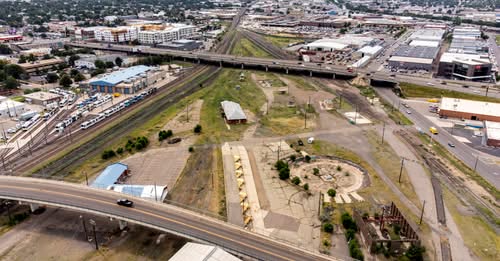Mayor Mike Johnston has made it clear that the future of Denver will be defined by bold investments in infrastructure, a relentless push to modernize key areas of the city, and a vision that merges urban development with the spirit of its residents. In recent months, his administration has been vocal about two major infrastructure projects that could change the face of Denver for decades to come. One of the most intriguing elements emerging from this announcement is the growing speculation that a new Denver Broncos stadium could rise at Burnham Yard, a historic but underutilized swath of land situated near downtown. This development, though not yet officially confirmed, has sparked waves of conversation across Colorado, ranging from excitement about economic opportunities to concerns over the shifting landscape of a city that has always prided itself on balancing progress with community identity. Johnston, who took office with promises to reinvigorate Denver’s infrastructure, has been deliberate in prioritizing projects that he believes will have a direct and lasting impact on the city’s future growth. His approach has been characterized by both pragmatism and a willingness to entertain ambitious ideas, and the Burnham Yard project encapsulates both of these traits.
The Burnham Yard site, which stretches across approximately 58 acres of prime urban land near downtown Denver, has long been considered one of the city’s most promising redevelopment opportunities. For decades, it was a major hub for rail operations, owned by Union Pacific Railroad, but in recent years the land has mostly sat idle, waiting for a visionary plan to bring it back to life. With its proximity to both the heart of Denver and major transportation corridors, the land is a prime candidate for mixed-use development. Now, as conversations about revitalizing this site gain momentum, the idea of anchoring the development with a new stadium for the Denver Broncos is beginning to gain traction. For Johnston, whose administration is still in the early stages of outlining detailed plans for Burnham Yard, the potential of a new stadium is as much about economic growth and urban vibrancy as it is about sports. A modern NFL stadium could serve as a catalyst for a wave of commercial, residential, and entertainment-related developments, creating a dynamic urban district that would draw locals and visitors alike.
The current home of the Broncos, Empower Field at Mile High, is still relatively modern by NFL standards, but it lacks some of the cutting-edge amenities and infrastructure that newer stadiums have incorporated. NFL franchises in cities like Las Vegas, Los Angeles, and Minneapolis have set a new standard for stadium design, blending luxury, advanced technology, and entertainment experiences that extend well beyond game days. Denver’s leadership is well aware of this trend and the potential benefits that come with it. While the Broncos organization has yet to make any formal statements about relocating or building a new stadium, the timing of these discussions is interesting. The team’s ownership group, led by the Walton-Penner family, has the financial means and the motivation to explore the idea of a next-generation stadium. Mayor Johnston’s interest in revitalizing Burnham Yard aligns with this potential vision, leading many to speculate that the city and the Broncos could form a partnership that would place Denver among the elite cities with state-of-the-art sports and entertainment venues.
Yet, this is not just about football. Johnston has repeatedly emphasized that any development at Burnham Yard must be holistic and community-centered. In several interviews and public forums, he has pointed out that infrastructure is not just about building big structures but about building connections — between neighborhoods, between economic opportunities, and between the past and the future. The redevelopment of Burnham Yard, he argues, could provide not only a space for sports but also much-needed housing, retail, green spaces, and cultural attractions. Denver has been grappling with challenges related to affordable housing and rapid population growth, and Johnston has suggested that any major infrastructure project must address these issues head-on. As such, any potential stadium project would likely be part of a larger, mixed-use development plan designed to serve both the city’s economic goals and the needs of its residents.
Critics, however, are cautious. The idea of using prime urban land for a stadium, which might sit empty for much of the year outside of game days and events, is controversial. Some urban planners argue that this land should be dedicated primarily to housing and transit solutions rather than sports. Denver has a history of balancing these competing priorities, and the conversation around Burnham Yard reflects the broader debate about how cities should grow in the 21st century. Johnston, for his part, has acknowledged these concerns, stating that his administration is committed to ensuring that any project involving Burnham Yard includes significant community input and transparent planning. He has also pointed to the potential for a stadium to be designed in a way that encourages year-round activity, with integrated public spaces, retail, restaurants, and entertainment venues that keep the area vibrant beyond football season.
The first of Johnston’s two major infrastructure priorities involves improving Denver’s transportation network. While details of this plan are still being finalized, the mayor has stressed the need for better connectivity, both within the city and to surrounding regions. Denver’s growth over the past decade has placed increasing strain on its roads, public transit, and bike lanes, and Johnston believes that a forward-looking infrastructure strategy is essential for maintaining the city’s livability. Any redevelopment of Burnham Yard would almost certainly tie into these transportation goals, with the potential for new transit hubs, pedestrian-friendly pathways, and improved access to major highways. The site’s location near existing light rail lines makes it particularly attractive for a project that aims to reduce car dependency and promote sustainable urban mobility.
The second major infrastructure priority revolves around housing. Denver has seen housing costs skyrocket over the past decade, and Johnston has made affordable housing a cornerstone of his agenda. The redevelopment of Burnham Yard, with its expansive footprint, offers a rare opportunity to create a substantial number of housing units in a prime location. Johnston has expressed interest in ensuring that a significant portion of any new residential development on the site is affordable to working families, rather than being dominated by high-end luxury apartments. He has also floated the idea of incorporating community spaces, parks, and cultural facilities to ensure that the redevelopment serves the broader public interest.
This dual focus — on transportation and housing — is emblematic of Johnston’s larger approach to governance. Rather than treating infrastructure as a series of disconnected projects, he sees it as part of a larger ecosystem that can drive economic growth, improve quality of life, and position Denver as a model for sustainable urban development. The speculation about a new Broncos stadium at Burnham Yard adds a dramatic layer to this vision, drawing both attention and scrutiny. For many Denver residents, the Broncos are more than just a football team — they are a cultural institution that binds the community together. A new stadium, especially one located in a central urban district, could become a landmark for the city and a symbol of its forward momentum.
However, major projects of this scale come with significant financial implications. Stadium construction costs have soared in recent years, with many of the newest NFL venues costing upwards of $2 billion. Questions about how such a project would be financed are already surfacing, with debates about the role of public funding versus private investment. Johnston has not yet detailed any financial framework for a stadium, but he has stressed that taxpayer interests will be a top priority in any negotiations. The Walton-Penner family’s immense wealth — with Rob Walton being one of the richest owners in sports — suggests that the Broncos could potentially fund a substantial portion of the costs themselves, but public infrastructure improvements around the stadium could still require city investment.
The coming months are likely to bring more clarity to these plans, but for now, Denver is buzzing with anticipation. The idea of combining a transformative redevelopment project with the construction of a world-class sports and entertainment venue has captured the imagination of many. It also reflects a broader trend in American cities, where stadiums are increasingly seen not as isolated structures but as anchors for entire urban districts. Projects like The Battery in Atlanta (home to the Braves’ Truist Park) and LA Live (adjacent to the Lakers’ Crypto.com Arena) have demonstrated the economic power of sports-centered developments when executed well. Johnston appears to be studying these models carefully, seeking to adapt their lessons to Denver’s unique character and needs.



